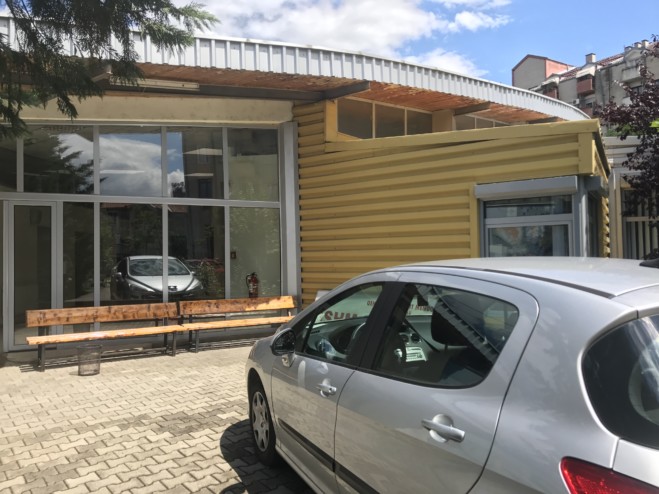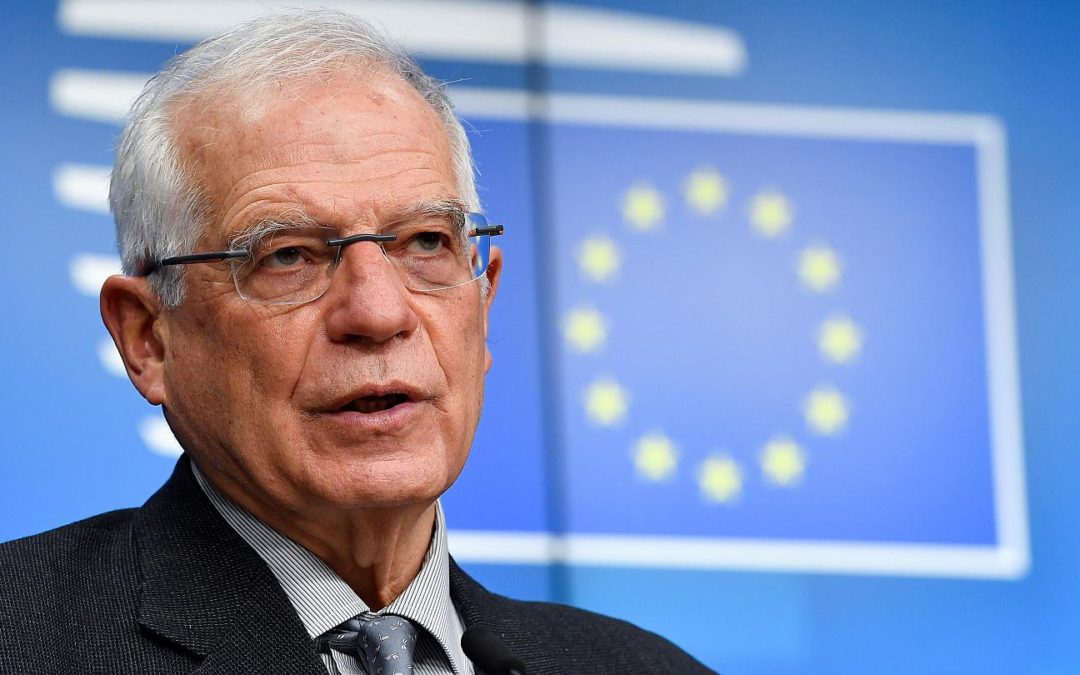A half-dozen patients sat on plastic folding chairs in the grass, smoking and chatting in the courtyard of Pristina’s Mental Health Center. It was mid-morning, birds chirping in the trees overhead.
The number waiting to see a doctor wasn’t large this morning. The center served 6,045 people during the past year, according to Dr. Sami Rexhepi, psychiatrist and director of the center. He is one of only two psychiatrists at the clinic.
Rexhepi started as a general practitioner with a focus in pediatrics in 1983 at the age of 23. As a young doctor, he did not have positive feelings toward psychiatry and the mentally ill.
“In the very beginning of being a young doctor, psychiatry- you cannot do a lot to help people,” Rexhepi said.
Then, in 1986 or 1987, he started working with teenagers and became exposed to the mental health problems many young people face.
Since he didn’t have the experience to deal with mental illnesses, he asked his colleague, who was a physiatrist, to help him. He referred his cases to her and she helped him learn about his cases. She was the main reason he studied psychiatry.
He studied psychiatry from 1993 to 1997. With his expertise, he worked as the director of the regional health authority in the Ministry of Health from 2000 to 2007. But a dislike for paperwork and management drove him to back to psychiatry, and he found a job at Pristina’s Mental Health Center in 2007.
“I feel for myself much better being a doctor because you can do much more than being in politics. Being a doctor, you can see your results. But being a manager, a lot of things do not depend on you,” Rexhepi said.
Three psychiatrists cover four centers: Pristina, Gllogovc, Podujeva, and Fushë Kosova. Rexhepi also visits the center in Mitrovica. These are not enough physiatrists to cover all four centers, Rexhepi said. The center in Pristina employs only 11 nurses.
Rexhepi said the center needs more nurses to better serve the needs of their clients, but there is not enough money in the budget.
“To cover all the needs of mental health services, we are not able,” Rexhepi said.
The center also employs a social worker, a psychological counselor, and psychology intern.
Pristina’s Mental Health Center is not the only center that is short-staffed. The integrated community house in Fushë Kosova only has five nurses to cover a 24-hour facility, Rexhepi said. Integrated community houses differ from centers for mental health in that they allow clients to stay for a period of time that can range from a few days to a week.
Community-based mental health centers focus on rehabilitating and treating chronically ill patients, who are usually referred to as clients. They do not stay overnight.
Pashk Buzhala, head of Public Health Division from Ministry of Health, said there are eight integrated community houses in Kosovo. There are eight centers for mental health in Kosovo: one in Pristina, Prizren, Gjilan, Gjakova, Peja, Mitrovica, Ferizaj, and Podujeva.
The center for mental health in Podujeva employs only three nurses, Rexhepi said. If two nurses leave to visit a client in their homes, that leaves only one nurse at the center.
Rexhepi meets with 10 to 15 patients a day. Those visits can range from 15 minutes for a quick checkup to 40 minutes for a full session.
Rexhepi said he focuses on gaining his client’s trust with these sessions, and the success of treatment depends largely on the trust he gains.


It was time for a group session in the cool white walls of Pristina’s center. The clients gathered in the center’s main room. Paper-mache and water-color artwork from the clients hung on the walls. Painted wine glasses and paper crafts sat in a wooden TV cabinet. A guitar zippered sat nestled into its case in the corner of the room for music time.
The clients, a psychosocial worker and a psychology intern moved the foosball table and pulled chairs into a circle. The staff went around the circle, asking each client about the activities they do to make them happy. Some of the clients speak in low tones, but the conversation turns lighter with laughter and smiles.
This is the kind of work Rexhepi enjoys, work that makes people feel better. He said he decided to become a psychiatrist because it is challenging but also gratifying to help the chronically ill function again in society.
Rexhepi’s office is a cool shade of white, matching with the center’s theme of neutral tones. He pointed to his computer.
“Would you like to see something?” he asked.
He pointed to his computer screen, where a man in a striped shirt sat on a torn couch.
“Now this person is head of family; he’s taking care of five children, his wife. He’s coming here twice or three times per week. Do you understand why I like this job? Or if you have one guy, fifteen or sixteen years of using drugs, and you help them overcome that. Do you know what it means to give someone a chance for new life?” Rexhepi said.
Rexhepi has other pictures of clients on his computer, the lives that he helped rebuild.
“I have found myself as being a doctor because it makes me happy, it fulfills me. It’s part of my life,” Rexhepi said.
Of course, Rexhepi could not run his clinic without his staff.
Vjosa Berisha, head nurse at Pristina’s Center for Community-based Mental Health, settled into her chair in an office splashed with pale blue, from the walls to the couches. The cool blue has a calming effect, especially for clients who feel overwhelmed and need a break from the world.
She has been at the center since it opened in 2003, facing the challenges of being a nurse for fourteen years.
One of those challenges is field visits. The Pristina center only has two old donated Kias, and no professional drivers. Three teams of six nurses must drive the cars themselves. Getting to rural areas with rough roads can be difficult, and if one of the old cars breaks down in a rural area, help is difficult to find.
Broken-down Kias aren’t the only challenges on the job. Coping with the difficult cases and celebrating progress has been a learning experience.
“It was harder in the beginning because they would get more attached to every case and they couldn’t accept that some people were suffering that much but with the passing years now it’s become more of a routine. When someone gets better they get very happy that they helped someone, when someone isn’t that good, they still can get over it without getting that much attached, but it’s still a long time and it’s tiring. It’s consuming mentally and physically,” Berisha said through a translator.
The life of a nurse can be tiring, and the nursing staff has decreased while the number of clients have increased since Berisha started. Nurses move on. One went abroad. Another left to be a nurse at the hospital. Some went into other fields like forensics, while others didn’t finish their education.
“So, if this is not the right career for you it’s best to just leave because you get very tired emotionally and physically and that’s why a lot of people can choose to pursue a different career,” Berisha said.
But there are the success stories that make her work worth it, she said. One of those stories was a client she found in a dirty apartment filled with cigarettes, trash and bottles. His brother called the clinic for help. She said the stench of the apartment was so bad, they had to cover their noses. Doctors and policemen delivered him to the psychiatric center, where he spent four weeks.
With the help of his family and therapy, he has now recovered. He comes to his sessions on his own and is self-sufficient. He could even get a job if he found one.
“So, when you see the success stories of some people actually treating their illnesses, that’s what makes me go on and sometimes maybe I don’t see the consequences that I have on myself but then I forget myself in helping others,” Berisha said, smiling and gesturing with her hands.
Berisha said in a few cases, a nurse can handle up to 80 clients. It’s difficult, but the nurses can juggle cases because of their experience.
“Pristina’s center is part of a community-based approach to mental health. Many centers were set up with the help of the World Health Organization (WHO) in 2001 or 2002 after the war of 1998-99. The idea of the center is to keep clients within the community,” Buzhala said.
Buzhala said it was recommended by the WHO to integrate patients into public spaces because keeping them in hospitals could create a stigma around mental health.
“This is a suggestion of the World Health Organization, they said that mental health clients should not be made to feel like they are clients. When they spend a lot of time in a hospital getting treatment, then they got stigmatized by the society. So, in order to remove that stigma, they did this kind of treatment in the community and it works pretty well,” Buzhala said through a translator.
But Rexhepi said the biggest barrier for accessing mental health services is still the stigma attached to the mentally ill.
“Asking for mental health services is the same as asking for a neurologist, cardiologist, but for them it’s not still safe,” Rexhepi explained.
For many, mental health needs remain seen as “something shameful or something that you can be marked in some way.”
(Laura Fitzgerald was a reporting intern at KosovaLive this summer, in cooperation with Miami University in the United States.)








